-
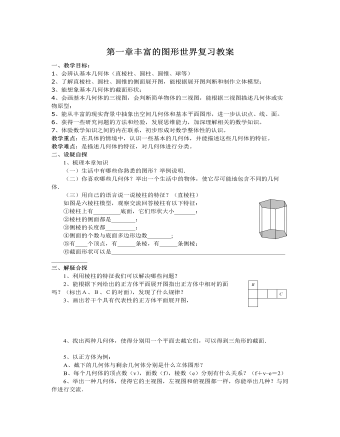
北师大初中七年级数学上册第一章复习教案
一、教学目标:1、会辨认基本几何体(直棱柱、圆柱、圆锥、球等)2、了解直棱柱、圆柱、圆锥的侧面展开图,能根据展开图判断和制作立体模型;3、能想象基本几何体的截面形状;4、会画基本几何体的三视图,会判断简单物体的三视图,能根据三视图描述几何体或实物原型;5、能从丰富的现实背景中抽象出空间几何体和基本平面图形,进一步认识点、线、面。6、获得一些研究问题的方法和经验,发展思维能力,加深理解相关的数学知识。7、体验数学知识之间的内在联系,初步形成对数学整体性的认识。教学重点:在具体的情境中,认识一些基本的几何体,并能描述这些几何体的特征。教学难点:是描述几何体的特征,对几何体进行分类。二、设疑自探1、梳理本章知识(一)生活中有哪些你熟悉的图形?举例说明.(二)你喜欢哪些几何体?举出一个生活中的物体,使它尽可能地包含不同的几何体.(三)用自己的语言说一说棱柱的特征?(直棱柱)
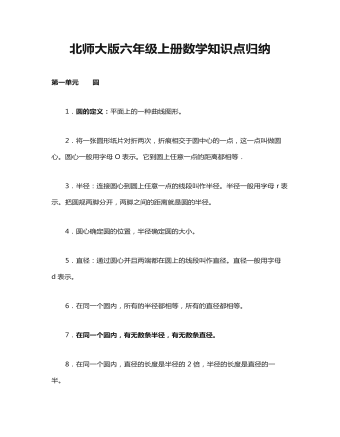
北师大版六年级上册数学知识点总结教案
第一单元 圆1.圆的定义:平面上的一种曲线图形。2.将一张圆形纸片对折两次,折痕相交于圆中心的一点,这一点叫做圆心。圆心一般用字母O表示。它到圆上任意一点的距离都相等.3.半径:连接圆心到圆上任意一点的线段叫作半径。半径一般用字母r表示。把圆规两脚分开,两脚之间的距离就是圆的半径。4.圆心确定圆的位置,半径确定圆的大小。5.直径:通过圆心并且两端都在圆上的线段叫作直径。直径一般用字母d表示。6.在同一个圆内,所有的半径都相等,所有的直径都相等。7.在同一个圆内,有无数条半径,有无数条直径。8.在同一个圆内,直径的长度是半径的2倍,半径的长度是直径的一半。用字母表示为:d=2r r =1/2d 用文字表示为:半径=直径÷2 直径=半径×2
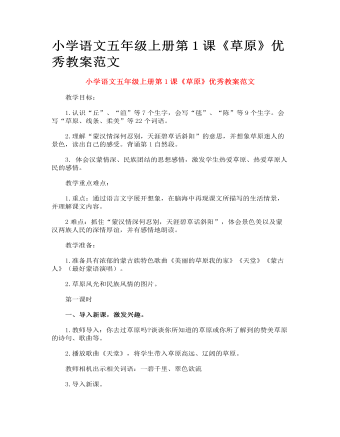
小学语文五年级上册第1课《草原》优秀教案范文
初读课文,学习字词。 1.提出读书要求:默读课文,一边读一边画出不认识的字和不理解的词,并借助词典等学习工具书理解。 2.教师检查学生学习情况。 (1)检查生字读音。 小丘( qiū)渲染(xuàn )迂回( yū)蒙古包( měng ) 襟飘带舞( jīn )鄂温克(è) (2)指导易混淆的字。 “襟”是左右结构,左边是“衤”,与衣服有关,表示衣服胸前的部分。 “涩”是左右结构,右边下面是“止”,不能写成“上”。 “裳”下面是“衣”,与衣服有关。 “微”:中间部分不能少一横。 (3)理解较难的词语。 ①联系上下文理解词语。 草原上行车十分洒脱,只要方向不错,怎么走都可以。 “洒脱”的意思是:潇洒自然,不拘束。这个词语反映了草原的广阔无边。 ②理解“襟飘带舞”一词的意思,可以出示蒙古族鲜艳的服装来分析,意思是:衣襟和裙带随风舞动。 ③“翠色欲流”一词可以从难字入手理解,比如“欲”在这里表示“将要”的意思,“翠色欲流”就是绿得太浓了,将要流下来,写出了草原的绿,是充满生命力的。 ④鄂温克:我国少数民族之一,聚居在内蒙古自治区的东北部。
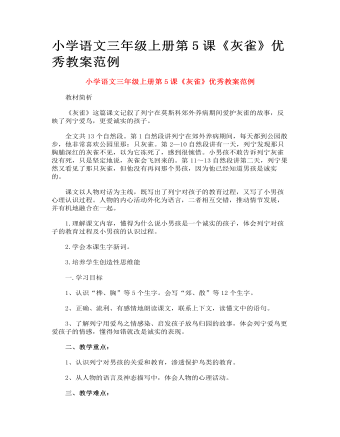
小学语文三年级上册第5课《灰雀》优秀教案范例
教材简析 《灰雀》这篇课文记叙了列宁在莫斯科郊外养病期间爱护灰雀的故事,反映了列宁爱鸟,更爱诚实的孩子。 全文共13个自然段。第1自然段讲列宁在郊外养病期间,每天都到公园散步,他非常喜欢公园里那:只灰雀。第2—10自然段讲有一天,列宁发现那只胸脯深红的灰雀不见,以为它冻死了,感到很惋惜。小男孩不敢告诉列宁灰雀没有死,只是坚定地说,灰雀会飞回来的。第11~13自然段讲第二天,列宁果然又看见了那只灰雀,但他没有再问那个男孩,因为他已经知道男孩是诚实的。 课文以人物对话为主线,既写出了列宁对孩子的教育过程,又写了小男孩心理认识过程。人物的内心活动外化为语言,二者相互交错,推动情节发展,并有机地融合在一起。
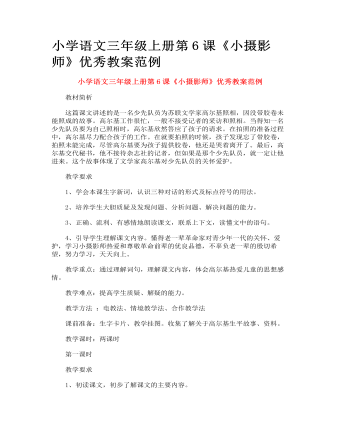
小学语文三年级上册第6课《小摄影师》优秀教案范例
介绍人物,导入新课 1、启发谈话。课前同学们自己已经读过了课文,查阅了有关资料,谁能向大家介绍一下高尔基? 2、学生之间交流收集的有关高尔基的资料。 3、师出示高尔基的画像,并归纳:高尔基(1886年~1936年),是苏联伟大的无产阶级文学家,世界著名的文学家。他写了很多书,发表了《童年》、《在人间》、《我的大学》、《母亲》等多部小说以及著名的散文诗《海燕》和一系列剧本。“书籍是人类进步的阶梯”这句脍炙人口的名言,就出自高尔基的笔下,全世界人民都很敬爱他。他的作品在我国广为流传,得到人们的喜爱。今天,我们来学习高尔基与一位小学生之间的故事:小摄影师。(板书,提示“摄”的读音。) 高尔基与小摄影师之间到底发生了什么事呢?我们下面来看课文
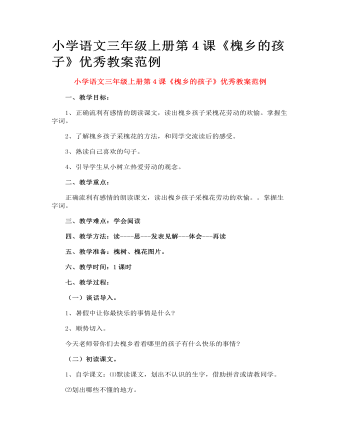
小学语文三年级上册第4课《槐乡的孩子》优秀教案范例
课堂上把重点放在了让学生在读的过程中体会出槐乡孩子的懂事、吃苦耐劳和以苦为乐的特点,因为是略读课文,所以我就只提了一个问题,槐乡的孩子与我们有什么不同呢?让学生通过各种方式的读说自己读了课文后的的体会。学生在回答时,大都抓住了“勤劳的槐乡孩子是不向爸爸妈妈伸手要钱的,他们上学的钱是用槐米换来的.”及槐乡孩子的勤劳,对此学生感受最深,槐乡孩子以苦为乐的精神,是靠我点出来了,当时有部分学生说第三段写的槐乡孩子干活时的样子写得很好,当时天很热他们还在干活.我就趁机引导学生朗读体会当时天气的热,又读一读描写干活时的句子,学生体会到孩子们劳动时是很快乐的。学生已经能够通过读文理解文中的内涵,但总结的能力不行,大都是只看到点,看不到面。反思本节课,虽然课文都是由学生具体读,但都是我直接参与指导方法等,是我一步步引着走的,属于半放半扶。下次的略读课我打算完全放手,由各学习小组的组长和学生一起学习。

人教版新目标初中英语八年级上册I’m going to be a basketball player教案3篇
教学目标1.知识目标:(1)学习What are you going to be when you grow up?/How are you going to do that?句式。(2)学会用英语描述有关职业的表达法。2.能力目标:(1)能够谈论为实现理想所做出的打算和安排。(2)能够谈论未来自己与他人理想的职业及原因。(3)能用英语描述课余时间的活动安排,最终具备表达综合信息的能力。3.情感目标:新学期到来之际,让他们在学习、体育、饮食、特长、读书等方面制定计划,教育学生合理安排自己的课外生活,思考自己的理想职业及适合自己的职业。教学重点、难点本单元的重点为“be going to”表将来,want to be, what,where, when,how引导的特殊疑问句。难点是语言目标的实现。教材分析本单元以I am going to be a basketball player为话题,共设计了三部分的内容:一、Section A该部分有4个模块。第一模块围绕Do you think these jobs are interesting?这一话题展开思维(1a)、听力(1b)、口语(1c)训练;

人教版新目标初中英语八年级上册I’m more outgoing than my sister教案2篇
1 交通工具的比较此活动为小组活动。学生通过讨论找出到达某一城市可乘坐的各种交通工具,并选择最佳出行方式。Teacher:We’re going to Shanghai. How many ways can we use to get there? Yes, there are four ways: by bus, by plane, by train, by ship. Please discuss how you are going to get there.操作建议:(1)学生以小组为单位展开活动,谈论本组所选择的交通工具。(2)各组选代表向全班汇报,阐述本组所选择的交通工具的利和弊。完成任务所需要的语言结构:We can go there by ship. It’s more comfortable and cheaper than any other transportation.We can go there by bus. It’s cheaper but it takes longer time.2 哪个城市更合适?此活动具有挑战性。假设中国要举行2014年世界杯足球赛,分别从历史,人文,天气等方面对各城市(北京,大连,上海,昆明)进行比较,选择最佳举办城市。T: Imagine China is holding the 2014 FIFA World Cup. Which city do you think is the best for the World Cup, Beijing, Dalian, Shanghai or Kunming? Let’s work in groups. If you choose Beijing, please join the Team Red. If you chose Dalian, please join the Team White. If you choose Shanghai, please join the Team Blue. If you choose Kunming, please join the Team Green. Please show us its advantages. Then let’s see which team will win.

人教版新目标初中英语八年级上册What’s the best radio station教案2篇
教学重点和难点:运用所掌握的语言描述,比较不同地点的特点。在练习中学习掌握英语比较级和最高级的用法。课前准备分配小组,每组五至六人。通过上网或翻阅报刊杂志等方法,确定旅游线路,做出基本的旅游计划。教学设计:本节课流程图 学法指导:1.由于这是一堂新课,在教学中应注意面向全体,发挥学生的主体性,引导学生积极参与,激发学生的求知欲和学习积极性,指导学生积极思维,主动获取知识,养成良好的学习方法。逐步学会独立解决问题。总之要尽可能调动学生的非智力因素促进智力因素的发展。教法选择:1.电化教学法2.课堂讨论法3.任务型教学法采用这些方法的目的是为了充分调动学生的学习积极性,使学生变被动学习为主动学习。通过电脑形象的演示,加强印象,提高兴趣,突破难点,提高教学效率,进而增大教学的容量和信息量。充分体现教师为主导,学生为主体的教学原则。

人教版新目标初中英语九年级上册How do you study for a test教案2篇
内容提示本单元主要内容是学会利用verb十by/with gerund表示方式方法来讨论学习英语的策略,认识自己在学习方面的长处和不足。初步了解现在完成时的结构和用法。现在完成时由助动词have/has+动词的过去分词构成,主要表示过去发生的某一动作对现在仍有影响或造成的后果,常与already,yet,just,ever,never等副词连用。教学目标一、学习目标(Language Goal) 1. Talk about how to study . 学会讨论各种学习方法和策略。2. Find out your suitable learning methods. 找出适合自己的学习方法。 二、语言结构(Language Structures) 1. Verb + by with gerund by+动名词短语 表示“通过…途径,方法” 2. How questions have引导的特殊疑问句 三、目标语言(Target Language) 1. How do you study for tests ? 你是怎样准备考试的?Well , I study by working with my classmates. 哦,我和同学们一起学习。2. Have you ever studied with a group ? 你曾经参加过学习小组吗?Yes , I have . I’ve learned a lot that way . 是的,参加过。通过这种方式我学了许多。

初中化学人教版九年级上册《实验活动3燃烧的条件》教案
【学习目标】1.知识与技能:加深对燃烧条件的认识,进一步了解灭火的原理。2.过程与方法:体验实验探究的过程,学习利用实验探究的方法研究化学。3.情感态度与价值观:利用化学知识解释实际生活中的具体问题,使学生充分体会到化学来源于生活,服务于社会。【学习重点】通过物质燃烧条件的探究,学习利用控制变量的思想设计探究实验,说明探究实验的一般过程和方法。【学习难点】利用控制变量的思想设计对照实验进行物质燃烧条件的探究。【课前准备】《精英新课堂》:预习学生用书的“早预习先起步”。《名师测控》:预习赠送的《提分宝典》。情景导入 生成问题1.复习:什么叫燃烧?燃烧条件有哪些?今天自己设计实验来进行探究。2.明确实验目标,导入新课。合作探究 生成能力学生阅读课本P150的相关内容并掌握以下内容。实验用品:镊子、烧杯、坩埚钳、三脚架、薄铜片、酒精、棉花、乒乓球、滤纸、蜡烛。你还需要的实验用品:酒精灯、水。1.实验:用棉花分别蘸酒精和水,放到酒精灯火焰上加热片刻。上述实验中我们能观察到什么现象?说明燃烧需要什么条件?如果在酒精灯上加热时间较长,会发生什么现象?答:蘸酒精的棉花燃烧,蘸水的棉花没有燃烧,说明燃烧需要有可燃物。如果加热时间较长,水蒸发后,蘸水的棉花也会燃烧。2.如图所示,进行实验:我们能观察到什么现象?说明燃烧需要什么条件?答:在酒精灯火焰上加热乒乓球碎片和滤纸碎片,都能燃烧,说明二者都是可燃物。放在铜片两侧给它们加热后可看到乒乓球碎片先燃烧,说明燃烧需要温度达到可燃物的着火点。3.你能利用蜡烛和烧杯(或选择其他用品)设计一个简单实验证明燃烧需要氧气(或空气)吗?答:点燃两支相同的蜡烛,然后在一支蜡烛上扣住一只杯子,看到被杯子扣住的蜡烛一会儿就熄灭,说明燃烧的条件之一是需要氧气。

人教版新目标初中英语七年级上册Can you play the guitar教案
本单元主要是学习情态动词can的肯定句、否定句、一般疑问句,肯定与否定回答,以及特殊疑问句的构成和用法;复习what弓!导的特殊疑问句。本单元主要围绕“加人俱乐部,谈论自己的能力”这一话题,设计了三个任务型活动:任务一是:自己的才艺表演,学习情态动词can的用法;任务二是:自己建立俱乐部,运用情态动词can谈论自己在某一方面的能力、喜好和意愿;任务三是:我能成功,主要是复习巩固谈论各自的爱好和特长的方法。单元知识系统(树)Can you/he/she/you dance? 一Yes,I/he/she/we can./No,I/he/she/we can’t.Can Bill play the guitar?一Yes,he can,but he can’t sing.单元总体目标通过学习情态动词can的用法,使学生能够表达自己在某一方面所具备的才能;能够谈论自己的喜好与意愿;能够为自己成立的各种俱乐部制作海报;会写招聘广告。单元重难点一览重点 难点I.复习词汇:can,play,want2.词汇:guitar, dance, swim,sing, chess, speak, drum,trumpet,violin,play the guitar3.句型:Can you/he/she/you dance?Yes,I/he/she/we can./No,I/he/she/we can’t.Can Bill play the guitar?

人教版新目标初中英语七年级上册Do you have a soccer ball教案
在这一单元中,学生要学会就有关人与物之间所属关系进行问答的句子。本单元大量引入有关运动的名词,要求学生彼此询问有无此类物品,并做出相应的回答。 同时学习表示建议的句型Let’s运动的形容词。 本单元所选用的话题来自学生所喜欢的生活片段,在教学中生生交流、师生交流会更融洽,会促进师生彼此间的了解,成功的教学还会让部分学生养成良好的运动习惯和收藏习惯。 教学目标 1) 语言知识:A.在询问对方是否有某物的对话中学会使用do和does引导的一般疑问句; B. 学会使用描述性的形容词来评价事物; C. 学会在对话中使用名词复数; D. 学会用祈使句来向对方提出建议. 2) 语言技能:A. 学会用祈使句询问某人是否有某物; B. 学会向他人提出建议的句子. 3) 学习策略:A.通过与同学讨论,做出猜测;

人教版新目标初中英语七年级上册Do you want to go to a movie教案
讨论喜欢的影视类型及理由:在看过一部影视作品后,大家总是喜欢在一起谈论影视的主要内容、主要情节、主要演员主题歌曲、主题音乐等,互相介绍自己对该影视的看法。教师可以组织一次活动,分组讨论学生喜欢看什么类型的电影,并说明喜欢的理由。运用I like…I don’t like…Because it is…等语言结构;然后每个组选派一名代表向全班学生阐述本组组员喜欢观看的电影类型;最后汇总,总结出全班同学最喜欢观看哪一种类型的电影。如果有可能,根据学生的选择放一部(一段)这种类型的影视节目。通过学生的讨论、调查,使他们在完成任务的过程中学会询问和陈述自己或别人在影视方面的喜好及理由,更好地巩固所学内容。Self Check教学内容Self Check(教材P58)教学目标知识与能力复习词汇go,movie,action,comedy,documentary,thriller,and,but,scary,funny, sad,exciting;引导学生复习、巩固“制订计划和打算并谈论喜好和偏爱”的目标语言。

人教版新目标初中英语七年级上册How much are these pants教案
个性练习设计 阅读广告:在日常生活中,人们去买东西之前,一般要阅读广告,从广告中获取该商品的一些有用信息,包括价格、性能等。所以给学生提供有些商品的广告或让学生去商店去阅读一些商品的广告,从中获取商品的价格,即可以锻炼学生的阅读能力,又能提高实践能力。 Self Check 教学内容 Self Check(教材P42) 教学目标 知识与能力 复习词汇pant,sock,T-shirt,sweater,shoes,color,black,white,red,green,blue,big,short,long,数字10--31; 学习词汇Zig Zag,clothes,shop,yellow,ask,which;学会谈论服装的价格、颜色、大小和长短;学会填写价格标签。 过程与方法 运用Summarizing和Classifying的学习策略。在复习教学中,运用听写、绘画、互相询问调查与检测等手段,促使学生不断地使用所学内容,从而提高他们灵活运用知识的能力。 情感态度价值观 该部分学习内容主要是复习谈论服装的价格和颜色以及对服装的喜好,能引起学生的共鸣;通过购物的对话练习教学生学会购物时使用的礼貌用语和如何感谢人。

人教版新目标初中英语七年级上册My favorite subject is science教案
本单元主要学习一周中星期一到星期天的表达方式;掌握学科的表达;学习用because和表示品质的形容词表示理由;学习what,why,who引导的特殊疑问句。本单元围绕“谈论自己所喜欢的学科”这一话题,设计了三个任务型活动:任务一是:谈论自己所喜欢的学科,学习what引导的特殊疑问句和学科的表达;任务二是:一分钟演讲,让学生介绍自己喜欢某一学科的理由,学习why等特殊疑问句;任务三是:写信,巩固和延伸所学知识,掌握星期的表达方式。单元知识系统(树)What’s your/his/her favorite subject? My/His/Her favorite subject is English.Why do you like math. Because it’s interesting.Why does he/she like art? Because it’s fun.When do you have math? I have math 0n Monday,Wednesday and Friday.What’s Ken’s favorite subject? Science.单元总体目标通过本单元的学习使学生学会谈论自己喜好的学科或自己喜好的其它事情并给出理由;学会说出一周的七天;学会合理地安排自己的作息时间。

人教版新目标初中英语七年级上册What time do you go to school教案
知识与能力复习词汇time,morning,breakfast,get up,g0 t0 bed,homework,clock,afternoon,lunch,run,watch TV,evening,dinner,eat,usually,o’clock,thirty,fifteen,take a shower,go t0 school等;引导学生复习、巩固“询问和谈论时间”的目标语言并运用所学知识安排自己的学习和课外活动。过程与方法运用Summarizing,Classifying和Comparing的学习策略。在复习教学中,运用听写、提问、对话演练与调查活动,促使学生不断地使用所学内容,从而提高他们灵活运用知识的能力。情感态度价值观本部分的主要内容是复习“日常作息时间”的询问和表达。通过互相询问或谈论自己或对方的作息时间安排和活动计划,培养学生良好的作息习惯和守时习惯。教学重、难点及教学突破重点复习词汇time,morning,breakfast,get up,g0 to bed,homework,clock,afternoon,lunch,run,watch TV,evening,dinner,eat,usually,o’clock,thirty,fifteen,take a shower,go to school等;引导学生复习、巩固“询问和谈论时间”的目标语言。

人教版新目标初中英语七年级上册What’s this in English教案
一、知识和能力目标本单元的核心教学内容是“认物”。用英语确认周围的常见事物比较符合英语初学者的实际情况。通过本单元教学,使学生运用所学句型,去熟悉周围事物的名称;教学生学会在实际生活中如何确认事物。通过辨认物体,学生学到一些生词,并巩固所学句型。二、过程和方法目标教师要尽量使学生对课文中出现的句型能够熟练上口,这样,学生才能顺利开展比较灵活的对话。教师可以用手势,表情,动作等示意,帮助学生听懂课堂教学内容,但在实际操作中应尽量避免“明知故问”的倾向,应该采用应用性原则;如:遮盖物品、显露局部、辨认物体、完形识别、图形辨认等方法。三、情感态度和价值观目标目标在学生学习过程中的作用至关重要,教师要帮助他们建立起一个切合自己实际的目标,通过渐进的学习以及一点一滴的进步,使他们逐步建立起成功感。成功越多,自信心就越强。

人教版新目标初中英语八年级上册Can you come to my party教案3篇
Step 3 (3b)First, tell the students when we talk about our future plans, we often use: I’m+verb+ing When we talk about what we must do, we use have to. Ask the students to fill in the blanks in 3b. The answers are: shopping, go to see, a test, I’m going, my family. Step 4 (3c)Let the students write an e-mail message to a friend. Say why you can’t visit next. Before the exercise, ask the students to give some possible answers and write them on the blackboard. So the students will feel easy to finish the writing exercise. After they finish it, Let them to correct it in groups first. Each group chooses theirs best one to read in front of the whole class. Step 5 ( planning a party )First read the conversation in the box together. Then ask the students to turn to page 88.Write down everything you have to do next week. Write in all the things you have to do . Ask the students to look at the list. Ask them “What day are you free?” This is when you can have your party. Step 6 (Self check 1 )Let the students to fill in the blanks with the words given. Change the forms of the words if possible. Then make their own sentences. The answers are: visit, playing, have to, study, comeStep 7 (Self check 2)Imagine you are Marie. Read the information and look at your schedule. Write replies to the invitation.

人教版新目标初中英语八年级上册How do you make a banana milk shake教案2篇
1. First, ... then, ... next, ... finally, ...首先,……然后,……接着,……最后,……这是英语中表达做某事的步骤的一种说法。如果步骤较多,还可以说:first-next-after that-later on-finally/at last通常你会听到说英语国家的人在说 first, next, then, finally 和后面的内容时,他们会做一些停顿。这样就能提前告诉听者接下来讲的是一系列的步骤。这一点在朗读和听力中应特别注意。2. how many, how much均为疑问词,同是“多少”,但用法不同。请看:how many修饰可数名词复数,how much修饰不可数名词。但在用法上,同学们常犯如下错误:1) [误] How many are there bananas on the table?[正] How many bananas are there on the table?[析] how many, how much 中的many,much是形容词,常修饰名词作定语,故后面跟名词。2) [误]How much tea are there on the table?[正]How much tea is there on the table?[析] how much修饰不可数名词时,谓语动词用单数。how many与how much的区别可简记为:前how many:问“多少”,复数名词后面跑;how much问“多少”,不可数名词单数好。前者答语用基数词,后者答语用数量关系。

